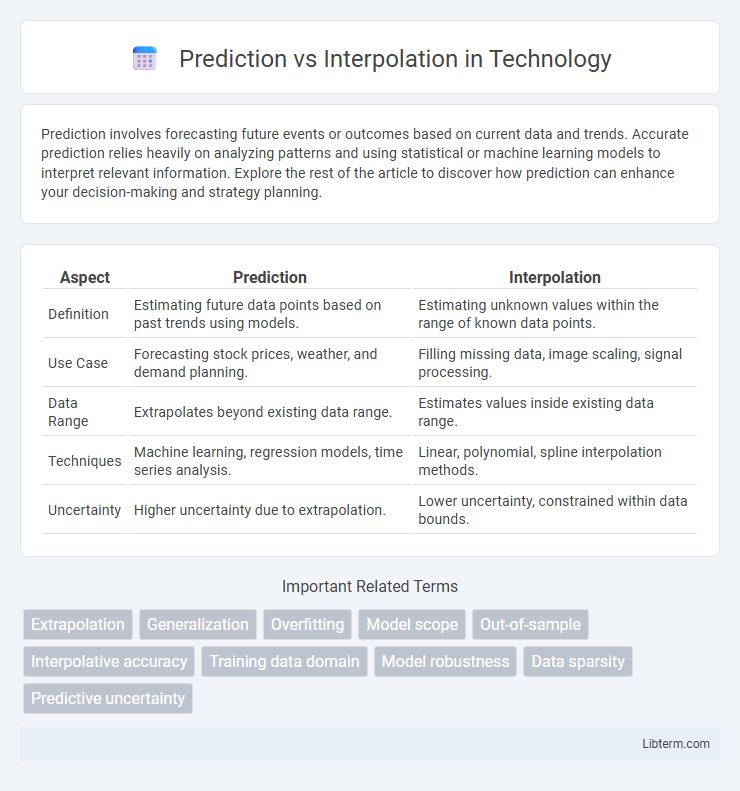Prediction involves forecasting future events or outcomes based on current data and trends. Accurate prediction relies heavily on analyzing patterns and using statistical or machine learning models to interpret relevant information. Explore the rest of the article to discover how prediction can enhance your decision-making and strategy planning.
Table of Comparison
| Aspect | Prediction | Interpolation |
|---|---|---|
| Definition | Estimating future data points based on past trends using models. | Estimating unknown values within the range of known data points. |
| Use Case | Forecasting stock prices, weather, and demand planning. | Filling missing data, image scaling, signal processing. |
| Data Range | Extrapolates beyond existing data range. | Estimates values inside existing data range. |
| Techniques | Machine learning, regression models, time series analysis. | Linear, polynomial, spline interpolation methods. |
| Uncertainty | Higher uncertainty due to extrapolation. | Lower uncertainty, constrained within data bounds. |
Understanding Prediction and Interpolation
Prediction involves estimating unknown future values based on patterns in existing data, often using statistical or machine learning models to forecast outcomes beyond observed points. Interpolation, by contrast, estimates values within the range of known data points, creating a continuous function that fills gaps in the dataset without extrapolating beyond existing observations. Understanding these concepts is crucial for applying appropriate analytical techniques in data science, ensuring accurate results in forecasting and data reconstruction.
Core Differences Between Prediction and Interpolation
Prediction estimates future or unknown values beyond the available data range using patterns or models, while interpolation estimates values within the existing data range by connecting known data points. Prediction relies heavily on model assumptions and trends to extrapolate outcomes, whereas interpolation assumes smooth transitions between data points without extending beyond them. The core difference lies in prediction's forward-looking scope versus interpolation's focus on filling gaps within known data.
Mathematical Foundations
Prediction uses mathematical models like regression analysis and time series forecasting to estimate future values based on learned patterns in data, relying heavily on probabilistic assumptions and model parameters. Interpolation involves constructing functions, such as polynomials or splines, that pass through known data points to estimate intermediate values, leveraging concepts from numerical analysis and approximation theory. Both techniques depend on underlying mathematical foundations including linear algebra, calculus, and statistical inference for accurate computation and error minimization.
Common Applications in Data Science
Prediction involves forecasting unknown future data points based on patterns in historical data, commonly used in machine learning models for stock price forecasting, customer churn analysis, and demand estimation. Interpolation estimates intermediate values within the range of a discrete set of known data points, frequently applied in sensor data smoothing, image processing, and geographical information systems (GIS) for terrain modeling. Both techniques leverage statistical and mathematical tools to enhance data-driven decision-making in diverse data science applications.
Advantages and Limitations
Prediction leverages known data to forecast unknown or future values, offering advantages in uncovering trends and facilitating decision-making under uncertainty. Its limitations include potential inaccuracies when extrapolating beyond the range of training data and sensitivity to model assumptions. In contrast, interpolation estimates values within the range of observed data points, providing higher accuracy and reliability, but it cannot predict beyond the given data boundaries and may fail to capture underlying trends.
Key Assumptions and Requirements
Prediction relies on models assuming underlying patterns or trends extend beyond observed data, requiring robust generalization and accurate feature representation. Interpolation assumes that data points lie within a continuous function or smooth surface, necessitating dense, high-quality data within the observed range for reliable estimates. Key requirements for prediction include model validation and handling extrapolation uncertainty, while interpolation demands spatial or temporal data continuity and minimal noise for precise results.
Popular Algorithms and Techniques
Popular algorithms for prediction include linear regression, decision trees, and neural networks, which model relationships to forecast future outcomes based on input data. Interpolation techniques commonly use methods such as spline interpolation, nearest neighbor, and kriging to estimate values within the range of observed data points. Machine learning frameworks like TensorFlow and scikit-learn support both prediction and interpolation through customizable models that optimize accuracy and computational efficiency.
Real-World Examples
Prediction involves estimating future data points based on historical trends, such as forecasting stock market prices using time series analysis. Interpolation fills in missing or intermediate values within known data sets, like estimating temperatures between recorded weather stations. Real-world applications include weather prediction models for forecasting storms and sensor calibration techniques that use interpolation to smooth data.
Challenges and Best Practices
Prediction faces challenges such as model overfitting, data sparsity, and uncertainty in extrapolating beyond observed data ranges. Interpolation requires careful selection of algorithms like spline or kriging to accurately estimate values within known data points, mitigating risks of artifacts or smoothness bias. Best practices involve validating models using cross-validation techniques, ensuring data quality, and choosing methods aligned with the underlying data distribution and application context.
When to Use Prediction or Interpolation
Prediction is used when estimating unknown values outside the range of existing data points, which is crucial for forecasting future trends or outcomes. Interpolation is appropriate when calculating values within the known data range, ensuring accurate estimates based on surrounding information. Selecting prediction or interpolation depends on whether the target value lies beyond or within the data boundaries, influencing model choice and accuracy.
Prediction Infographic

 libterm.com
libterm.com